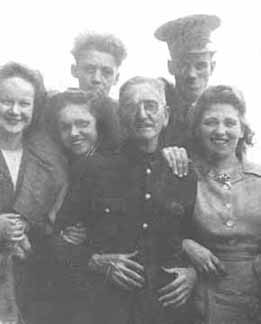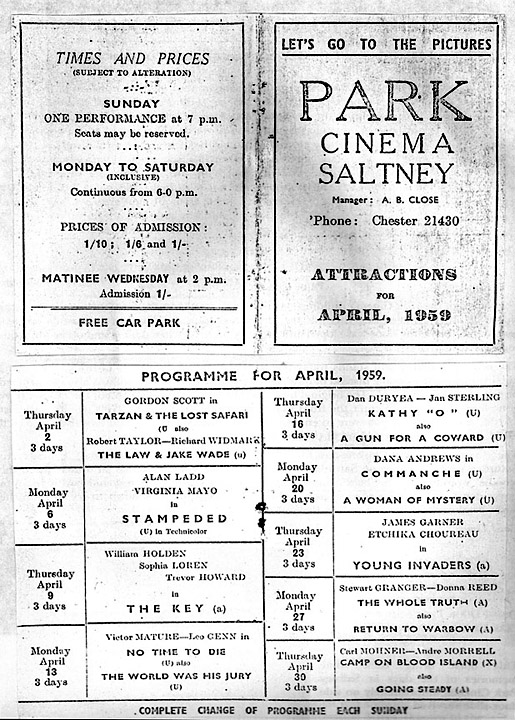 Chester's only suburban cinema, the Park, in Coronation Street ('Cinema Hill') Saltney, opened for business on May 21st 1923. Chester's only suburban cinema, the Park, in Coronation Street ('Cinema Hill') Saltney, opened for business on May 21st 1923.
The local vicar, the Rev J Philips and W. H Roberts, a former chairman of the East Saltney Council, performed the opening of the single-level hall, which was owned by Sydney Harold Booth and Wilfrid Francis Grierson.
ln September 1923 they formed The Park Cinema Saltney Ltd. Deeside Enterprise Cinemas owned the cinema after then until it closed in 1959.
The opening attraction at the 489-seat hall was the Sherlock Holmes thriller Moriarty. Proceeds from the first afternoon performance went to the now-closed Chester Royal Infirmary.
In the silent days, a piano and violin accompanied the flickering images. With the building having a corrugated tin roof, one would imagine that some very loud- and unwelcome- sound effects must have been produced during a hail storm!
The proscenium width was 26ft. The main picture hall was l00ft long and 40ft wide. The box office telephone number was 21430.
The manager at the time of closing was the apty-named Mr A. B. Close. He had joined the cinema in 1933 as a projectionist. In 1938 he became the manager, taking over from a Mr Waring. Other members of staff over the years were: Joe Bolton, doorman and Bob Dixon, chief projectionist. He was called up to the army and John Lightfoot took over. His brother was a projectionist at the Majestic Cinema (next page) in Brook Street.
 During WW2, the Park was used as an Air Raid Precautions Post (ARP). Servicemen could freely use the cinema but the management would count them and send the bill to the Army! During WW2, the Park was used as an Air Raid Precautions Post (ARP). Servicemen could freely use the cinema but the management would count them and send the bill to the Army!
Occasional live shows took place there such as one in the 1940s, when Gypsy Petulengro and his Romany Orchestra played there. In addition to the music, Petulengro also told fortunes. That shows such as this were infrequent is demonstrated by the fact the staff had to construct a stage especially for them over the front stall seats out of oil drums and staging borrowed from the Royalty Theatre in Chester. The local coal merchant, Charles Randles, fetched the staging on the back of his coal wagon.
Our photograph of some of the Park's staff shows (left to right) Joan Partington, Jessie Roberts, Johnny Owen, Joe Bolton, Bob Dixon, Nellie Willets and Alf Dixon.
The Park's interior was quite sumptious. Six suspended domed lights ("like upside down mushrooms") lit the auditorium which was painted maroon except for the foyer, which was done out in two-tone blue. The screen curtains were of maroon velvet. The seats (except for the plain tip seats at the front) were upholstered in maroon and green velvet. There were double seats at the back of the auditorium- doubtlessly very popular! Seats could be reserved. Before each performance, staff would hurry out and put signs on the booked seats.
In contrast, the cinema's exterior, as the rather murky photograph at the top of the page shows, was not a thing of architectural beauty. It was nontheless still doing good business at the time of closure. John Lightfoot tells me that a director wanted to leave, so the Park had to be sold. John and the manager wanted to rent the hall but the offer was refused.
The old Park building still stands today, albeit disguised by an extra layer of brickwork on the outside, making it a double rather than single layer of bricks. A new roof was also constructed atop the original roof. The original front door has not changed much but the railings have vanished from the steps. The interior has been converted into offices (picture to follow). If you go out of the building's back entrance (the old exit for the picture house), there is a small power substation with some very old but clear graffitti on there, reading 'YANKS GO HOME'. This dates from WWII when there was something of a bad feeling in the area regarding the American servicemen and the home-grown girls! They would take the girls to the cinema and be faced with this friendly message when they left...
Do you have any photographs of the Park in its heyday? We'd very much appreciate a borrow of them to scan for inclusion here!

The Park's utilitarian interior in 1923

The last surviving programme before the Park Cinema closed in 1959
Back to Brook Street, Chester, to visit a former cinema that later became a ballroom and a bingo hall, the Majestic
|
 Chester's only suburban cinema, the Park, in Coronation Street ('Cinema Hill') Saltney, opened for business on May 21st 1923.
Chester's only suburban cinema, the Park, in Coronation Street ('Cinema Hill') Saltney, opened for business on May 21st 1923.  During WW2, the Park was used as an Air Raid Precautions Post (ARP). Servicemen could freely use the cinema but the management would count them and send the bill to the Army!
During WW2, the Park was used as an Air Raid Precautions Post (ARP). Servicemen could freely use the cinema but the management would count them and send the bill to the Army!
